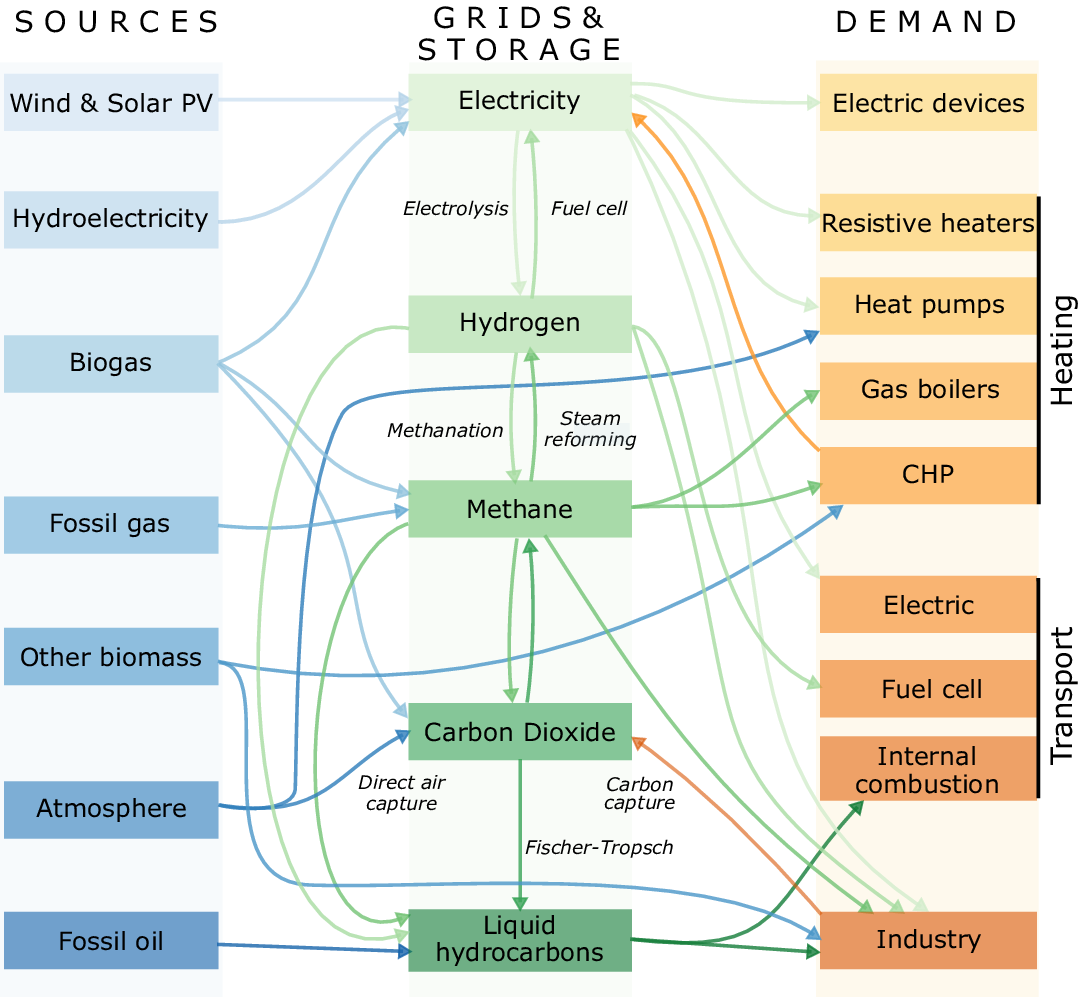config.default.yaml should be copied to config.yaml by new users. That way config.yaml doesn't change every time the developers use new settings. A basic "Getting Started" section is added to the README. Changes to be committed: modified: .gitignore modified: README.md renamed: config.yaml -> config.default.yaml
5.1 KiB
PyPSA-Eur-Sec: A Sector-Coupled Open Optimisation Model of the European Energy System
WARNING: This model is under construction and contains serious problems that distort the results. See the github repository issues for some of the problems (please feel free to help or make suggestions). There is neither documentation nor a paper yet, but we hope to have a preprint out by summer 2020. We cannot support this model if you choose to use it.
PyPSA-Eur-Sec builds on the electricity generation and transmission model PyPSA-Eur to add demand and supply for the following sectors: transport, space and water heating, biomass, industry and industrial feedstocks. This completes the energy system and includes all greenhouse gas emitters except waste management, agriculture, forestry and land use.
This diagram gives an overview of the sectors and the links between them:
PyPSA-Eur-Sec was initially based on the model PyPSA-Eur-Sec-30 described in the paper Synergies of sector coupling and transmission reinforcement in a cost-optimised, highly renewable European energy system (2018) but it differs by being based on the higher resolution electricity transmission model PyPSA-Eur rather than a one-node-per-country model, and by including biomass, industry, industrial feedstocks, aviation, shipping, better carbon management, carbon capture and usage/sequestration, and gas networks.
PyPSA-Eur-Sec includes PyPSA-Eur as a snakemake subworkflow. PyPSA-Eur-Sec uses PyPSA-Eur to build the clustered transmission model along with wind, solar PV and hydroelectricity potentials and time series. Then PyPSA-Eur-Sec adds other conventional generators, storage units and the additional sectors.
Currently the scripts to solve and process the resulting PyPSA models are also included in PyPSA-Eur-Sec, although they could in future be better integrated with the corresponding scripts in PyPSA-Eur. A stumbling block to sharing solve_network.py between PyPSA-Eur and PyPSA-Eur-Sec is the different extra_functionality required to build storage and CHP constraints.
Spatial resolution of sectors
Not all of the sectors are at the full nodal resolution, and some are distributed to nodes using heuristics that need to be corrected. Some networks are copper-plated to reduce computational times.
For example:
Electricity network: nodal.
Electricity demand: nodal, distributed in each country based on population and GDP.
Building heating demand: nodal, distributed in each country based on population.
Industry demand: nodal, distributed in each country based on population (will be corrected to real locations of industry, see github issue).
Hydrogen network: nodal.
Methane network: copper-plated for Europe, since future demand is so low and no bottlenecks are expected.
Solid biomass: copper-plated until transport costs can be incorporated.
CO2: copper-plated (but a transport and storage cost is added for sequestered CO2).
Liquid hydrocarbons: copper-plated since transport costs are low.
Installation
First install PyPSA-Eur and all its dependencies. Clone the repository:
projects % git clone git@github.com:PyPSA/pypsa-eur.git
then download and unpack all the data files.
Create a parallel directory for PyPSA-Eur-Sec with:
projects % git clone git@github.com:nworbmot/pypsa-eur-sec.git
Package requirements
The requirements are the same as
PyPSA-Eur. For
solve_network.py in addition you need gurobipy. If you have
xarray version >= 0.15.1, you will need the latest master branch of
atlite version 0.0.2.
Data requirements
The data requirements include the JRC-IDEES-2015 database, JRC biomass potentials, EEA emission statistics, Eurostat Energy Balances, urban district heating potentials, emobility statistics, timezone mappings and heating profiles.
The data bundle is about 640 MB.
To download and extract it on the command line:
projects/pypsa-eur-sec/data % wget "https://nworbmot.org/pypsa-eur-sec-data-bundle-190719.tar.gz"
projects/pypsa-eur-sec/data % tar xvzf pypsa-eur-sec-data-bundle-190719.tar.gz
Getting started
First make your own copy of the config.yaml:
projects/pypsa-eur-sec % cp config.default.yaml config.yaml
In config.yaml you can control the settings for the scenarios you
want to run, such as the number of nodes, the CO2 limit, the
installable potentials for solar and wind, which technologies are
activated, etc.
To run the full optimization with your settings:
projects/pypsa-eur-sec % snakemake
Warning: you may need a cluster for this (with e.g. 10-100 GB of RAM and several processors).
To only prepare the networks, you can run the scripts up to the point before optimization:
projects/pypsa-eur-sec % snakemake prepare_sector_networks
